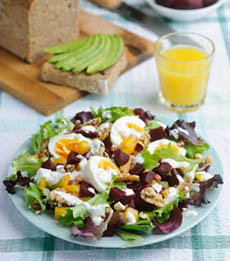PRODUCT: Love Beets, Ready To Eat
|
|
Americans don’t eat enough beets. Love Beets, a packager of cooked beets in several enticing formats, wants to change that.
Growing up in a beet-centric household of Russian descent, we know beets as a truly versatile vegetable that can be enjoyed hot or cold in just about everything—from sandwiches to soup (borscht!) to red velvet cake and ice cream (our beet ice cream was the hit of our 2000 “millennium dinner” on New Year’s Eve). So our heart fluttered when we discovered Love Beets’ fresh-cooked, ready-to-eat, conveniently designed clamshell packages of beets, with a fork included. There are also plain cooked beets (conventional or organic) that can be used as a salad or sandwich topper, side dish or healthful snack. There‘s beet juice (delicious!) that can be enjoyed plain, in a smoothie or in a Beet Martini. The line is all natural, gluten free, non GMO and certified kosher by OU. |
|
|
Baby beets are harvested young for a sweeter taste and cooked until tender; then packaged plain or infused with complementary flavors: |
||
|
We enjoy the flavor-infused beets straight from the package, or with a side of plain nonfat yogurt—it’s the healthier version of the Russian beets and sour cream.
MORE WAYS TO ENJOY BEETS Ruby red baby beets add a delicious kick to just about anything. |
 Add beets to side salads or luncheon salads: here, with hard-cooked eggs and crumbled bacon. Photo courtesy LoveBeets.com. |
|
|
Return to your roots: Enjoy more beets! Find more delicious beet recipes at LoveBeets.com. BEET TIPS You can use cooked beets in any recipe that requires raw beets. Just reduce the cooking time accordingly. Alas, beet juice does stain. If you aren’t a very neat eater, wear dark clothing! But beet juice is a water-soluble dye, so try one of these methods to clean up stains: Beets, or Beta vulgaris, evolved from wild sea beet, which grew wild in places as wide-ranging as Britain and India to Britain. The wild sea beet was first cultivated in the eastern Mediterranean and Middle East—although only the leaves were eaten! (Even today, beet greens are delicious. Don’t throw them away: Sauté them.) In early times, the medicinal properties of the root (the red bulb) led that portion to be used to treat a range of ailments from constipation, fevers, skin problems and wounds. The Romans cultivated beets; early recipes included cooking beets with honey and wine (that’s still a good recipe today). Apicius, the renowned Roman gourmet, included a beet broth recipe in his cookbook as well as beet salad with a dressing of mustard, oil and vinegar. The original beet roots were long and thin like carrots. The rounded root shape of today was developedin the 16th century and by the 18th century was widely cultivated in Central and Eastern Europe. Many classic beet dishes originated in this region, including borscht. In 19th century England, beets’ dramatic color was popular to brighten up salads and soups. The high sugar content made it a popular ingredient in cakes and puddings. Today there are many varieties of beets sizes large and small, including candy-striped (with red and white concentric circles), orange, white and yellow. Look for these specialty beets in farmers markets.
|
||
